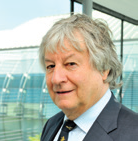Keep up to date with the latest research and developments from Diamond. Sign up for news on our scientific output, facility updates and plans for the future.
 Professor of Physics, Trinity College, Oxford & University of Oxford; Keynote speaker at the 2015 User Meeting
Professor of Physics, Trinity College, Oxford & University of Oxford; Keynote speaker at the 2015 User Meeting
2015 marked the centenary of the death of Henry Moseley, a pioneering physicist who used X-rays to reveal the atomic number of each element. His work led to the discovery of X-ray spectroscopy, a now widely used, non-destructive technique using X-rays to find out which elements are present in any sample. In the space of a few short months in 1913 and 1914, Moseley solved one of the greatest scientific mysteries of his time: using X-ray spectroscopy to order correctly the elements of the periodic table. Moseley was just 27 when he concluded his discovery. It is generally acknowledged that had it not been for his untimely death at Gallipoli in the First World War in August 1915, he would have won the Nobel Prize for Physics.
Science has many stories to tell. It is through these stories that we are able to demonstrate the impact of research and discovery, and inspire the next generation of scientists, engineers and mathematicians. Marking the centenary of Moseley’s death was an opportunity to tell his story, not only about his discoveries but also the man behind the research; his experimental and instinctive genius, and his tenacity and generosity of spirit.
Heralding these great figures of science and revealing the people behind the discoveries demonstrates that we are not so far removed. Anyone who attended any of the many Moseley exhibitions and talks that took place throughout 2015 would have appreciated that “Harry” was not just a scientist, but also a soldier, a brother, and a son. Everyone can relate to that in some way.
Diamond’s film tribute to Moseley, Henry Moseley: Science’s Lost Hero, can be viewed here.
 Chairman of the Board of Directors
Chairman of the Board of Directors
Fourteen years ago a Joint Venture Agreement was signed between the UK Government and the Wellcome Trust to create Diamond Light Source Ltd. Now in its ninth year of operations, the Diamond synchrotron is well established as a vital tool for the UK scientific academic and industrial community, as well as serving researchers overseas.
The scientific landscape is a rapidly changing one. The next phase of operations will bring a variety of technical challenges and open up new lines of scientific enquiry. Diamond needs to build on its achievements so far in terms of skills, technology and knowledge dissemination, and arm itself with the best ideas and highest scientific aspirations to remain competitive on the world stage. Diamond’s strong commitment to train the next generation of scientists, engineers and technicians is central to the UK’s future, ensuring the necessary skills and experience to truly grow knowledge and innovation for its economy and society at large.
Over the next decade, Diamond will implement its 10-Year Vision strategy to establish the facility sustainably as a world-leading centre for synchrotron science supporting excellence from UK universities, research institutes and industry. This vision will focus on the contribution synchrotron science can make and the impact that work carried out at Diamond has on the societal challenges that affect us all, from healthcare and the environment, to more energy efficient devices and transport.
It is amazing to see how Diamond’s scientific outputs and underpinning technology permeates, and will continue to do so, the eight great technologies in which the UK is set to be a global leader; and this is why Diamond plays such a critical role in the UK scientific landscape.
Diamond Light Source is the UK's national synchrotron science facility, located at the Harwell Science and Innovation Campus in Oxfordshire.
Copyright © 2022 Diamond Light Source
Diamond Light Source Ltd
Diamond House
Harwell Science & Innovation Campus
Didcot
Oxfordshire
OX11 0DE
Diamond Light Source® and the Diamond logo are registered trademarks of Diamond Light Source Ltd
Registered in England and Wales at Diamond House, Harwell Science and Innovation Campus, Didcot, Oxfordshire, OX11 0DE, United Kingdom. Company number: 4375679. VAT number: 287 461 957. Economic Operators Registration and Identification (EORI) number: GB287461957003.